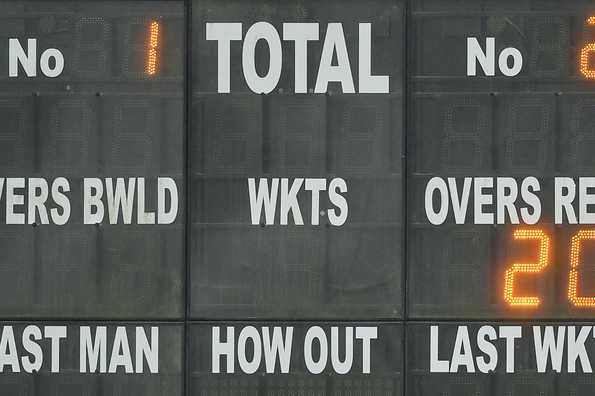The International Cricket Council (ICC) has announced alterations to the Playing Conditions for Twenty20 Internationals, with the most significant change impacting PowerPlay calculations. Specifically, the duration of the PowerPlay will now be calculated to the nearest ball, instead of the nearest over.

Under existing regulations, the first six overs constitute the PowerPlay, representing approximately 30% of a full 20-over innings. Shortening an innings means the rounding to the nearest over can significantly impact the game.
When the number of overs for the batting team is reduced, the number of PowerPlay overs will be adjusted according to the table below. This table applies to both the first and second innings of a match.
| Match reduced (overs) | Powerplay overs |
|---|---|
| 5 | 1.3 |
| 6 | 1.5 |
| 7 | 2.1 |
| 8 | 2.2 |
| 9 | 2.4 |
| 10 | 3 |
| 11 | 3.2 |
| 12 | 3.4 |
| 13 | 3.5 |
| 14 | 4.1 |
| 15 | 4.3 |
| 16 | 4.5 |
| 17 | 5.1 |
| 18 | 5.2 |
| 19 | 5.4 |
Previously, an 8-over innings would have contained two PowerPlay overs, while a 9-over innings would have had three. According to the new table, the PowerPlay will now end after 2.2 and 2.4 overs, respectively, maintaining a proportion closer to 30%.
The ICC stated that the change has been successfully implemented in the T20 Blast in England for years. The ICC Men's Cricket Committee has now accepted this method. For example, in an 8-over innings, the umpire will signal the end of the PowerPlay after 2 balls of the 3rd over. Three additional fielders will then be allowed to move outside the inner circle.
The ICC had previously advised that concussion replacements in Men's T20I matches must be identified and named before the match starts. This rule aims to ensure a level playing field by removing the advantage of the home team having access to a larger pool of players. The recommendation is to nominate the following concussion replacements to the match referee before the match:
The ICC acknowledges that Associate Member teams playing T20I matches might face challenges identifying five specific concussion replacement players for every match, especially when playing overseas. To address this, the system adopted for Associate Member T20Is will accommodate these limitations.
Teams can nominate a batter as the replacement wicketkeeper. The referee may require the nominated batter to keep wicket if used as the replacement wicketkeeper. Alternatively, the referee may allow another player in the starting XI to keep wicket instead of the nominated replacement, at their discretion. The goal is to ensure a like-for-like replacement, without providing an unfair advantage.
Teams are also permitted to nominate the same player for multiple categories. For instance, if an all-rounder is nominated for more than one position and replaces a batter, the referee might restrict them from bowling, treating them solely as a batter replacement.
There has never been a requirement for the concussion replacement to be restricted to the playing squad, allowing teams to nominate any eligible player. The overriding principle remains a like-for-like replacement, with the referee having the discretion to assess replacements based on the specific circumstances.
Examples:
Under exceptional circumstances, the match referee may consider a replacement player who is outside of the nominated replacements submitted by the team for the match, which is covered in the nomination form.
The ICC states that if any substance, including saliva, is used to alter the condition of the ball, the ball must be replaced. A new clause prevents the ball from being automatically changed if a team deliberately applies saliva to force a replacement.
These changes apply exclusively to the Men's playing conditions. The Women's playing conditions will be updated in October. The new playing conditions will be effective from July 10, 2025.
Newer articles
Older articles
 5 Overlooked Warning Signs of Colon Cancer: Early Detection Saves Lives
5 Overlooked Warning Signs of Colon Cancer: Early Detection Saves Lives
 Shukla's ISS Arrival Heralds New Era for Indian Space Exploration; Gaganyaan Mission Looms
Shukla's ISS Arrival Heralds New Era for Indian Space Exploration; Gaganyaan Mission Looms
 Vijay Sethupathi Apologizes Amid Controversy Over Son Surya's Film 'Phoenix'; Thalapathy Vijay's Support Revealed
Vijay Sethupathi Apologizes Amid Controversy Over Son Surya's Film 'Phoenix'; Thalapathy Vijay's Support Revealed
 Android Security Alert: Government Warns of Critical Flaws Exposing User Data
Android Security Alert: Government Warns of Critical Flaws Exposing User Data
 Skin Deep: 7 Warning Signs on Your Skin That Could Signal Heart Trouble
Skin Deep: 7 Warning Signs on Your Skin That Could Signal Heart Trouble
 Ashada Gupt Navratri 2025: Dates, Significance, and How to Observe This Hidden Festival
Ashada Gupt Navratri 2025: Dates, Significance, and How to Observe This Hidden Festival
 Smith Eyes Grenada Test Return After Injury Layoff
Smith Eyes Grenada Test Return After Injury Layoff
 Staying Hydrated May Significantly Lower Risk of Heart Failure, New Study Suggests
Staying Hydrated May Significantly Lower Risk of Heart Failure, New Study Suggests
 Moto G54 Price Slashed in India: Check Out the New, Lowered Costs
Moto G54 Price Slashed in India: Check Out the New, Lowered Costs
 Gambhir Sidelines Pant's Twin Tons After India's Test Loss, Emphasizes Team Performance
Gambhir Sidelines Pant's Twin Tons After India's Test Loss, Emphasizes Team Performance